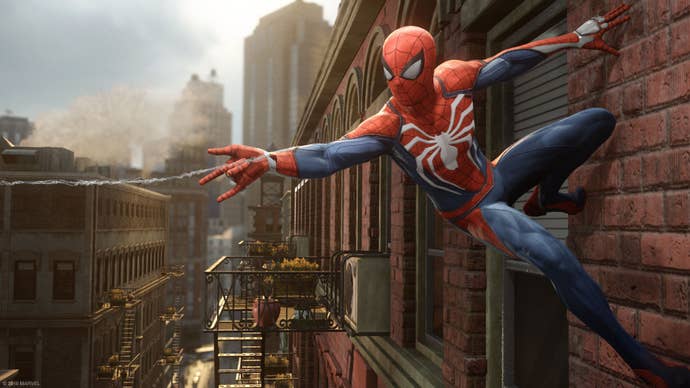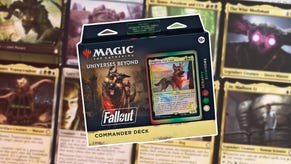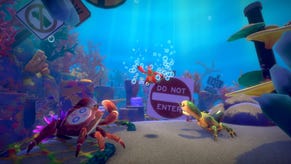The Video Game History of Every Major Hero in Avengers: Infinity War
From Spider-Man to Thanos, we catalogue the history of every major Avengers: Infinity War hero from the Atari 2600 to the PS4.
This article first appeared on USgamer, a partner publication of VG247. Some content, such as this article, has been migrated to VG247 for posterity after USgamer's closure - but it has not been edited or further vetted by the VG247 team.
Avengers: Infinity War has a lot of heroes in it—an almost stupid number of them, in fact. A lot of the talk will be about how their presence represents the culmination of more than a decade of Marvel Cinematic Universe films. But they also comprise more than 30 years of video game history.
From the Atari 2600 to the PlayStation 4, heroes have been an important part of gaming since the early days of the medium. Taking on the role of Iron Man or The Incredible Hulk is a powerful fantasy that resonates more than ever. Some of the games starring these heroes have been amazing; many have been terrible. One way or another, though, they are an indelible part of gaming history.
So let's a hop into a time machine and take a trip through history to revisit each major hero from Avengers: Infinity War and the games they've starred in, for better or worse.

The Avengers
Captain America
First Appearance: Captain America in: The Doom Tube of Dr. Megalomann [Commodore 64, 1987]
A lot of folk would expected Captain America and the Avengers in this opening spot, but the Sentinel of Liberty actually debuted a little earlier. This game was developed by a company called Adventure Soft for consumer-range PCs at the time, including the Commodore 64, ZX Spectrum, and Atari ST. The game placed Cap up against Dr. Megalomann, who isn't even really a Marvel Universe character.
In the fairly simple action game, Cap has to infiltrate Dr. Megalomann's base to stop a virus the fearful physician was going to release on the hapless populace. As Captain America, players use their limited amount of shields to stop Megalomann's henchman, but you could run out of shields if you didn't recall them for some reason. Unique at the time was the one hour time limit, with the game being played in real-time.
It wasn't very good and you're playing better off skipping this lost bit of history.

Iron Man
First Appearance: Captain America and the Avengers [Arcade, 1991]
Iron Man has been around for a long time, but he was comparatively late to the party when it comes to games. His first appearance was in 1991's Captain America and the Avengers arcade game—a serviceable if not altogether remarkable beat 'em up. And it was kind of all downhill from there.
Outside of a handful of appearances in Capcom's fighters, Iron Man's games have almost never been good. His solo action games in the late 2000s were so execrable that they pretty much killed Sega San Francisco. Like Captain America, Iron Man's games were very much the victim of the rapid development process that comes with licensed games based on movies, and their difficulties were exacerbated by Sega San Francisco's inability to staff up properly. The resulting action games, to put it charitably, were not pretty.
Interestingly, Iron Man is one of the only heroes on this list to actually show up as a villain in a video game. He appears in his Hulkbuster Armor Mk. II if Hulk causes too much destruction in The Incredible Hulk for the PlayStation 3, and he's quite a nasty foe. It's a pity Iron Man's solo ventures are mostly forgettably because a hero with multiple high-tech powersuits seems like a natural subject for a game.

Thor
First Appearance: Avengers in Galactic Storm [Arcade, 1995]
Thor's first appearance was in a fighting game, but it wasn't one by Capcom, weirdly. Rather, Thor made his playable debut in 1995's Avengers in Galactic Storm—a fairly primitive 3D fighter by Data East. He was mostly a background character from that point onward, appearing in Thanos' stage in Marvel Super Heroes, acting as a partner assist in Marvel vs. Capcom, and filling out the roster in Marvel Ultimate Alliance. He finally got his own solo adventure with Thor: God of Thunder, and it was… not very good. It was panned for bad combat, worse animation, and many, many glitches.
Thor was never the most popular Marvel character; and unlike Iron Man, he never experienced quite the same renaissance in film until last year's Thor: Ragnarok (though Chris Hemsworth is a legitimate star). But after being outright ignored for many years, Thor finally got a little more respect in the post-MCU films, even appearing in Marvel vs. Capcom 3 as a playable character. But otherwise the God of Thunder has never quite resonated with gaming audiences.


Hulk
First Appearance: Questprobe Featuring The Hulk [1984, Apple II, Commodore 64]
Hulk is known as the unstoppable force of destruction, but his first video game appearance was in… an adventure game? Yep, Hulk's video game debut was in 1984's Questprobe, a trilogy of command-based adventure games for the Apple II and Commodore 64 featuring Spider-Man, The Human Torch, and The Thing. It had fantastic art for its time, but the graphical splendor resulted in severely limited commands, hurting overall gameplay.
Later games were more in line with what you might expect from Hulk. The 16-bit Incredible Hulk is a platformer, the Hulk for the PS3 and Xbox 360 is a 3D beat 'em up with stealth elements. But the version that really rises above the pack is Hulk Ultimate Destruction—basically a destructible sandbox that you can run around destroying at your leisure. It might be one of the two or three best standalone superhero games ever made.
Hulk isn't the cinematic force he used to be—the current iteration hasn't starred in a standalone film since 2008's abortive Ed Norton film—but the appeal of running around smashing things is obvious. Of all the Avengers listed here, Hulk best encapsulates the pure fun of throwing your toys around the room and just being destructive.

Spider-Man and the Rest of the Heroes (And Villains)
Spider-Man
First Appearance: Spider-Man [Atari 2600, 1982]
Spider-Man is by far the most successful Marvel hero this side of, maybe, the X-Men. He boasts one of the best superhero games ever made, and has appeared on almost every console to date, with PlayStation 4 next on the list. Popularity will do that for you.
Spider-Man made his debut way back on the Atari 2600, and his game was pretty serviceable as far as early Atari games went. You would climb up a building using your web, avoid enemies, and try to disarm bombs set by the Green Goblin. You could even swing a little bit. It was primitive, but it felt faithful to the Spider-Man brand.
Later games struggled with pairing Spidey's trademark webslinging with 2D platforming. Arcade beat 'em ups like Maximum Carnage made Spidey feel slow and robotic. The transition to 3D liberated Spider-Man, allowing him to swing between buildings in vast sandboxes. To this day, the PlayStation 2's Spider-Man is probably the game that comes closest to capturing the feel of being Spider-Man, or any superhero really.
Spider-Man remains an iconic film, comic, and video game character; and with his return to the MCU fold, he's as popular as ever. His upcoming PS4 adventure certainly won't be his last.

Dr. Strange
First Appearance: Amazing Spider-Man vs. Kingpin [Sega Master System, Sega Game Gear, 1991]
For a very long time, Dr. Strange has been the go-to guy in the Marvel Universe if you had a problem of a mystical nature. The character was unique in his original stories because his tales were more surreal and laden with metaphor than his heroic counterparts. Outside of his own trippy, mind-bending adventures by co-creators Steve Ditko and Stan Lee, the good Doctor eventually went on call for the rest of the Marvel heroes whenever writers needed to have them interact with magic.
The Amazing Spider-Man vs. Kingpin will be known to most retro players simply as "Spider-Man" for the Sega Genesis/Mega Drive, Master System, and Game Gear. While Strange didn't appear in the Genesis version of the game, the Master System and Game Gear versions had Strange acting as an advisor to Spider-Man, helping him to find the keys needed to defuse the Kingpin's bomb. Since Spider-Man finds these keys on his own in the Genesis version, it's almost like Strange was just bored and willing to help out.
It's certainly one of the odder appearances of a cameo character on this list, and Strange would later get a fully-playable turn in Marvel Ultimate Alliance, like a number of other characters.

Black Panther
First Appearance: Marvel Ultimate Alliance [Xbox 360, PS3, PC, Wii, 2006]
Despite first appearing back in a 1966 issue of Marvel's Fantastic Four, Black Panther's world domination feels like it's only just begun thanks to this year's record-breaking Marvel film. Hopefully this means we will see more of Black Panther in video games as well as the character only started appearing in video games back in 2006 as a playable character in the action RPG Marvel Ultimate Alliance.
Marvel Ultimate Alliance and its sequel are best-remembered for their large pool of playable characters players can choose from. Especially cool is the freedom the game gives players to build their own superhero teams by either mixing-and-matching their favorite Marvel characters into four-person teams, or recreating popular canon teams like the Fantastic Four or Avengers.
Black Panther would later go on to make other mainstream video game appearances as a playable character in Marvel vs. Capcom Infinite. But so far his appearances have mostly been in mobile Marvel games. Something that will hopefully be changing soon.

Guardians of the Galaxy
First Appearance: Ultimate Marvel vs. Capcom 3 [Xbox 360, PS3, PS4, Xbox One, PC 2011]
The Guardians of the Galaxy are kind of a unique case. The version of the team featured in the Marvel Cinematic Universe have only been a thing in the comics since 2008. The previous users of the Guardians of the Galaxy moniker was a team of heroes in the future of the Marvel Universe, a more galaxy-spanning version of the Avengers. The team with Star-Lord, Rocket Raccoon, Gamora, Drax, and Groot, alongside Adam Warlock, Mantis, and a new Quasar, debuted in Annihilation: Conquest, a crossover that was itself a sequel to the Annihilation event a few years earlier.
As such, while many of the characters in the team hail from Marvel of the 1970s, this version of the team couldn't really appear in games until after 2008. Ultimate Marvel vs Capcom 3 is the first game to feature any of the characters acknowledging the Guardians as a whole, with Rocket Raccoon joining the game's roster in his comic Guardians outfit. His match win statement also notes, "The Guardians of the Galaxy are nothing without me."
The rest of the team would appear sporadically in Marvel toy box games like Lego Marvel Super Heroes or Marvel Heroes, but eventually everyone on the team appeared together in Guardians of the Galaxy: The Telltale Series, based heavily on the film.

Thanos
First Appearance: Marvel Super Heroes [Arcade, 1995]
Before Capcom started making the popular Marvel vs Capcom fighting games, Capcom was in charge of developing fighting games based strictly on Marvel properties. One of which was the 1995 arcade fighting game Marvel Super Heroes. This is also where Thanos made his video game debut.
Loosely based on the Infinity Gauntlet comic story which inspired this year's Avengers film, Marvel Super Heroes introduces Thanos as the main villain of the game. He is later playable as an unlockable character, but until then he serves as the big bad that all the other Marvel characters must defeat.
Like Avengers Infinity War, Thanos plots to collect the Infinity Gems to destroy the universe. That is unless players collect the Infinity Stones first and use it against him. Like Marvel vs Capcom Infinite decades later, players can collect unique Infinity Gems to gain select power boosts or stat buffs. Actually, this might be a good game to play if you're waiting to see the film this weekend.

The Supporting Cast
Avengers: Infinity War's supporting cast are mostly limited to ensemble games like Marvel Ultimate Alliance and Capcom's Marvel vs. Capcom fighting games. Vision and Hawkeye made their video game debut with Iron Man in Captain America and the Avengers; and for a certain subset of the fandom, Vision will always be all-white rather than his orange and green look in the film. Black Widow first appears in 2005's The Punisher, where she lends a hand to Frank Castle. Black Widow, as it happens, might be the most underutilized character in the entire MCU.
With the rise of mobile, Marvel games have increasingly been relegated to free-to-play titles. A host of Marvel heroes have received their own games on iOS, most of them very bad. The Lego Marvel's Avengers games have similarly done well with younger audiences. Capcom is still making Marvel vs. Capcom games; but their most recent attempt—Marvel vs. Capcom Infinite—can generally be categorized as a failure.
Amusingly, Stan Lee—best-known for creating many of Marvel's characters and making a host of cameos in the films—has more video game appearances than many of Infinity War's cast. He narrated several Spider-Man games, appeared as a senator in Marvel Ultimate Alliance 2, and was playable in The Amazing Spider-Man 1 and 2. In the Lego games, he could even become Stan-Hulk and Iron Stan.
The decline of licensed games has reduced the opportunities for characters like Winter Soldier to get their own games on consoles. These days, only the absolute biggest heroes like Spider-Man and Batman get their own games. But with Spider-Man coming soon to the PS4, and Avengers reported to be in development by Crystal Dynamics, the tide may well be turning a bit with licensed games. And who knows, The Collector may finally get his chance to shine.









